Energy supply for the people
In Chapter 7, you learnt about electrical circuits and electrical components. You also learnt about the international signs that are used to draw diagrams for these circuits.
In this chapter, you will learn more about the practical aspects of electricity and how it affects people, particularly in informal settlements and rural areas. You will learn what different sources of energy are used for heating, lighting and cooking, and how illegal electricity connections cause problems for the country.
Lastly you will discuss how our country needs to provide access to electricity for households, industries and buildings such as schools and hospitals. You will write a report on this topic.
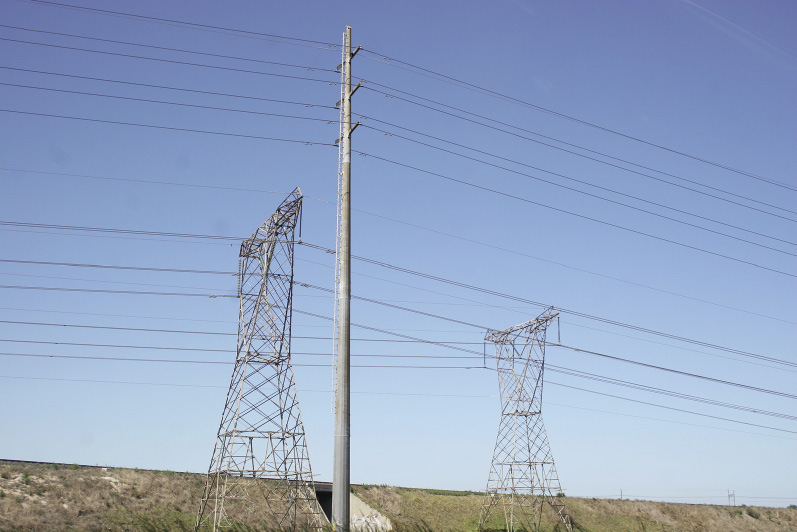
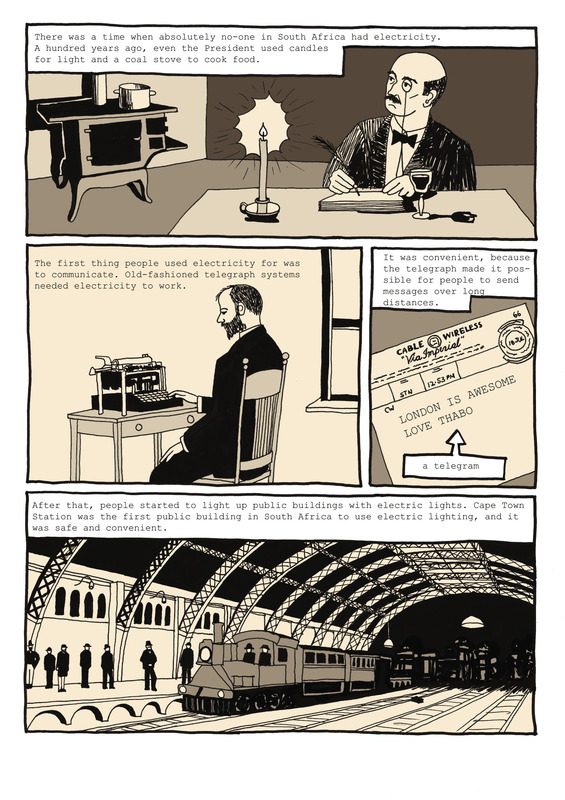
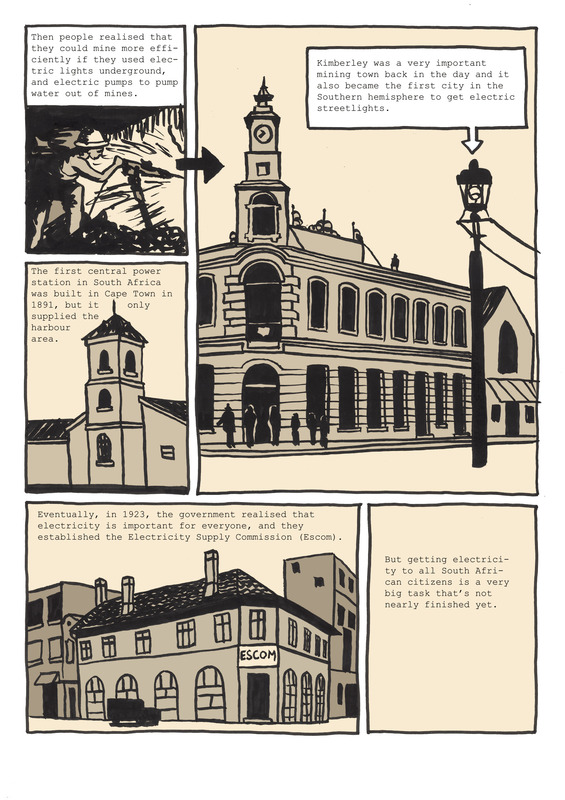
Energy usage in rural and informal settlements
Before electricity: Clever ways of finding and using energy
In earlier times, before the introduction of electricity, communities made clever plans to get light and heat − aspects of life that modern humans, entirely dependent on various forms of electricity, simply take for granted. Let's see what communities in our country used for fuel and lighting before the advent of electricity.
African smiths discovered how to produce high temperatures in their village furnaces by burning wood. In these furnaces, they manufactured steel for weapons and implements. The furnaces date back over 2 000 years. Wood from the indigenous acacia robusta tree, which is particularly hard and therefore smoulders when it is lit, was used in these Iron-age furnaces. The same wood was also used for cooking fires and for lighting purposes.
Early "ovens" that were created by digging large holes and lining them with dung and other heat-retaining substances, were also used thousands of years ago.
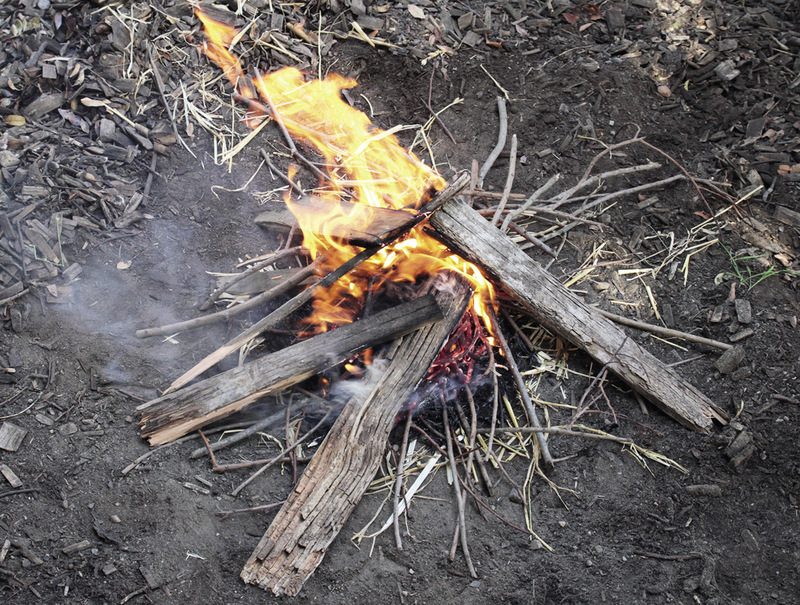
Energy for heating, lighting and cooking in rural and informal settlements in the late twentieth century
Electricity was introduced in the country early in the twentieth century, but was mainly allocated to cities and industrial areas. As the century progressed, electricity reached more populated areas, but rural and informal settlements were still mostly not connected. As late as 1994, only 1% of rural households had access to electricity! Other methods had to be used.
Heating
Coal and charcoal were the fuels mainly used for heating in the absence of firewood. Wood was cheaper than coal, but it was harder to obtain because the areas around the settlements had been stripped by earlier inhabitants.
Another source of energy was gas, but this was also expensive, and needed special equipment such as gas bottles and factory-made elements to heat the houses and shacks.
Paraffin was another popular source of energy because it was easy to obtain and the heaters that burnt paraffin could be bought quite cheaply. But paraffin has safety concerns, which you will look at later in this chapter.
A heating element converts electricity to heat through resistance encountered in the material the element is made of. When gas is used, the burning gas heats the element, which retains and radiates heat.
Lighting
Lighting is a necessity in daily life. Imagine trying to do your homework in the dark! By 1994, candles were still the main source of lighting in rural areas. Eighty-two per cent of households relied on candles to provide lighting after dark.
Lights using paraffin as a fuel source made up most of the balance − nearly 17% of the households. People who used gas for cooking could also use the gas for lighting, and a few households relied on their wood and coal fires to provide light. Gas, wood and coal were not very efficient.
A very small number of people could use electricity: almost less than 1% of the population of informal settlements.
Cooking
Paraffin was the fuel mostly used for cooking in informal settlements: over 90% of the people used paraffin cookers. Wood-burning and coal-burning stoves were used by almost all of the other households, with gas only occasionally being used for cooking.
Even though some areas were supplied with electricity, less than half of these people used it to cook. Stoves and electrical appliances were too expensive for most people living in informal settlements.
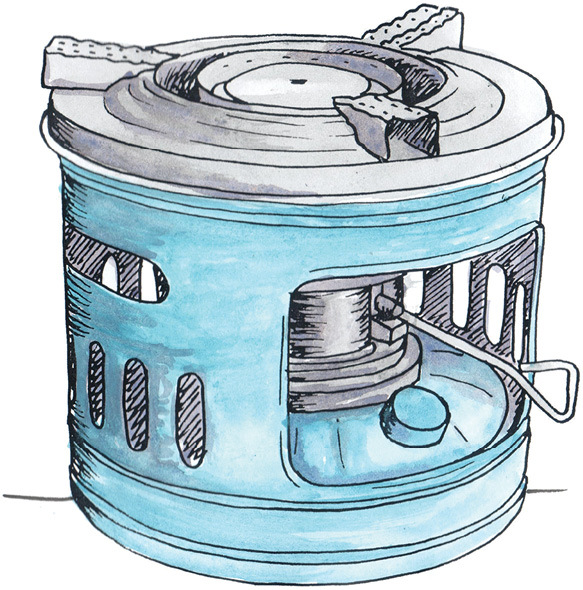
Fire risks due to open fires as a source of energy
Open flames are always dangerous. Informal settlement housing is normally built from materials that burn easily, and the shacks and houses are often built very close together. People without electricity who are forced to use fire for heating, lighting and cooking have to be extremely careful. Carelessness can cause major fires. When a major fire occurs, emergency services have difficulty putting it out since there are no access roads for their fire engines or water points for their hoses. But due to the lack of basic services, such as electricity, people opt for the use of alternative, often dangerous, energy sources out of necessity.
A rural settlement is far away from any towns, cities or big industries, such as mines. An informal settlement consists of temporary houses for people who moved closer to a town, city or industry, usually to find work. Rural settlements are often far away from power stations, as well as from towns and cities where there are already electricity transmission lines. It is expensive to build electricity transmission lines to far-away places. It also takes times to plan and build them. Some people in rural settlements cannot afford to pay for electricity. Informal settlements are usually built very quickly and without planning, so there is no time to plan or build electricity transmission lines before the people move there. Some people in informal settlements cannot afford to pay for electricity either.
1. Imagine you were put in charge of changing the way electricity is supplied to benefit the population of the country.
(a) Looking at the percentages of the population that had an electricity supply, what would your main goal be?
(b) Which section of the population do you think needs the most attention?
(c) Write four or five things that you will investigate before you decide to supply a rural or informal settlement with electricity for the first time.
For example: I would investigate the safety aspects of allocating electricity to informal settlements.
The present: Energy for all South Africans
The South African government announced its policy to provide free basic services to the poor in 2000, the main areas of focus being free basic water, sanitation and power supply.
Electricity is generally cheaper than traditional forms of energy such as coal, paraffin, candles and wood. Even if the direct cost of electricity is not cheaper than the direct cost of wood, the indirect savings or advantages need to be taken into account. For example, members of a rural family could spend hours gathering and chopping firewood, hours that could be spent doing something else if they had electricity.
For the government to achieve their aim, about 210 000 households a year are being connected to the national grid and another 10 000 a year are supplied with renewable energy.
The electricity network across South Africa is called the national grid. It includes power stations, power lines and substations.
Renewable energy is energy that comes from resources that will not run out. The sun and wind are the most common sources of renewable energy.
Of the 12,8 million households that are electrified in South Africa, about 52 000, mostly in rural areas, are being supplied by basic solar power. This is when the sunâs energy is gathered to charge batteries that are then used to power appliances.
By 2013, 85% of the country had been given access to electricity. In 1994, only 37% of the country had electrical power, so it can be said that the government's policy is effective.
The government is also encouraging poorer people to get connected to the electricity system by offering an amount of free electricity. This is currently 50 kWh per household, per month.
Investigate:energy resources
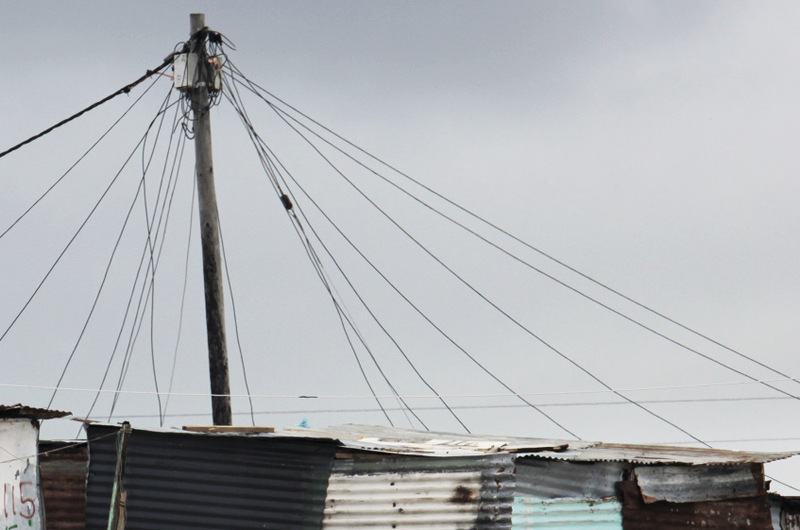
Andile lives here. He plans to be an engineer and wants to find out what the people in his community need. He already knows the following:
- The people in this community pay for energy when they use vehicles such as cars, buses and taxis. The petrol is the energy resource these vehicles need.
- The people also pay for energy when they buy food to eat. Food is the energy resource they need to function.
Now he wants to ask them about the energy they use for heating their homes in winter, for cooking food and boiling water, and for light at night.
He separates the energy resources from the systems they use. For example, paraffin is an energy resource that people pay for. But they use paraffin in different systems: paraffin stoves, paraffin heaters, paraffin lamps, and even fridges that work with paraffin.
Help Andile get his questionnaire ready: Individual work
Complete the table below and on the next page by writing what you expect people living in different households will tell you about the different energy resources they use and the different systems they use them in. The first table is for households that do not have electricity, and the second table is for households that do have electricity.
You will find pictures of systems that use the energy resources in Chapter 5, Chapter 7 and in this chapter.
|
Households without electricity |
||
|
I think that people will tell us about these ENERGY RESOURCES: |
I think we will hear about these SYSTEMS and USES of the energy resources: |
DISADVANTAGES or RISKS of using these energy resources: |
|
paraffin |
||
|
coal |
||
|
wood |
||
|
candles |
||
|
batteries |
||
|
gas |
||
|
sunlight |
||
|
Households with electricity |
||
|
I think that people will tell us about these ENERGY RESOURCES: |
I think we will hear about these SYSTEMS and USES of the energy resources: |
DISADVANTAGES or RISKS of using these energy resources: |
|
paraffin |
||
|
coal |
||
|
wood |
||
|
candles |
||
|
electricity that is not supplied by batteries |
||
|
batteries |
||
|
gas |
||
|
sunlight |
||
Unsafe and illegal electricity connections
ESKOM and other companies generate (make) electricity and supply it to users through long wires called power lines. The users include shops, factories, mines or people who live in flats, shacks or houses. The users connect to the big power lines through thinner cables that go through metering boxes. The metering boxes measure the amount of energy used.
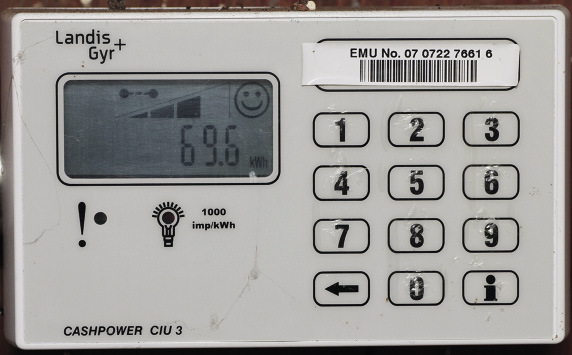
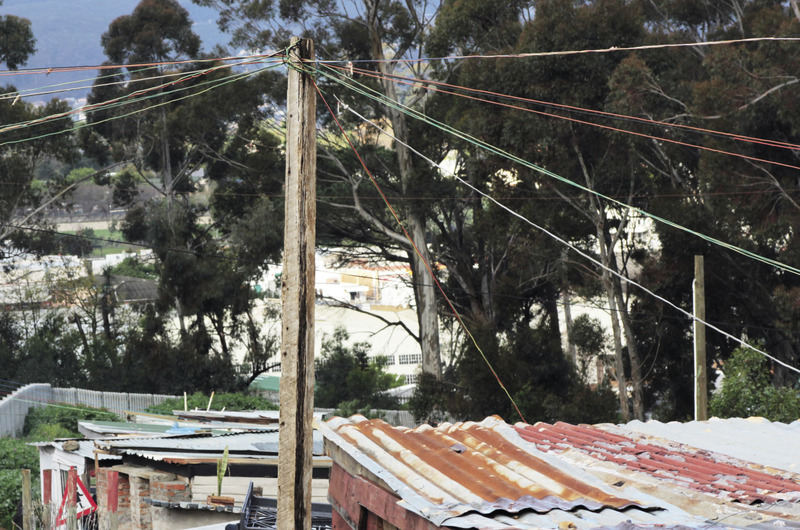
The electricity company needs money to buy coal, new generators, and to pay the people that maintain the generators. This is why we have to pay for electricity.
Electricity is not a cheap energy resource, which is why some people make illegal connections. Look at Figure 7. You can see the wires people have connected to an electricity pylon. These are illegal connections; the word "illegal" means "against the law".
The law says that only a qualified electrician can connect a building to the main electricity supply from the municipality, which is called "the mains". The mains supply electricity with an energy level of about 220 volts. This much energy is enough to kill you. This means poorly connected wires can really hurt someone and cause a short circuit that could start a fire. You learnt about short circuits in Chapter 5.
Electricians have been trained to make proper and safe connections, and know how to connect the mains to the metering box. However, there are people who think they know how to work with electricity, and they connect wires to the mains on their own. Since this is illegal they don't connect a metering box. They will often use bare wire, without any insulation, that hangs in trees or lies on the ground. They leave wires where they can easily come into contact with corrugated zinc-iron walls and roofs, or gates and fences, or be cut by metal window-frames. They forget or don't know that all these metal objects can become conductors that will carry 220 volts of electricity if they come into contact with the illegal live wires from the mains. These connections can easily cause short circuits that often cause fires in shacks and houses.
The price of stolen electricity
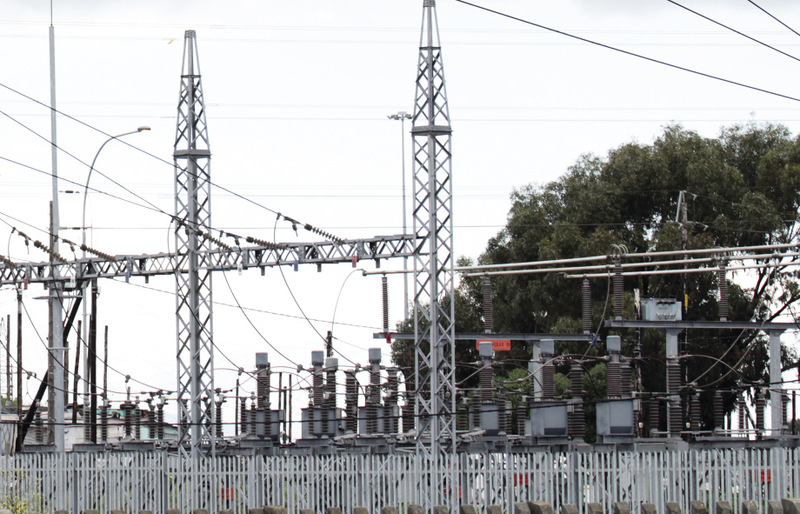
Illegal connections are dangerous, and cost the whole country money! How does electricity theft affect the following groups of people, and what actions can they take to help stop this crime?
This is a discussion task. Work in groups of three or four.
1. The community:
(a) How are they affected by electricity theft?
(b) What actions can they take to help prevent electricity theft?
2. Schools:
(a) How are they affected by electricity theft?
(b) What actions can they take to help prevent electricity theft?
3. The government.
(a) How are they affected by electricity theft?
(b) What actions can they take to help prevent electricity theft?
Sharing electricity fairly
In section 8.1, you learnt how South Africa's government is improving the electricity supply so that more people can have access to electricity in their homes.
Electricity has to be generated by ESKOM, and they not only have to supply individual households, but also tend to the whole country's electricity needs. As you know, some systems are targeted by thieves, such as street lights and traffic lights. These are municipal systems. Who else requires electricity?
Consumers of electricity
Work with a classmate on this exercise.
- Try to think of every situation where electricity is required by users in South Africa.
- Think about transport, manufacturing and private users.
- Think about "hidden situations" where electricity is used, such as pumping water to households.
- Does your school use electricity?
Examples are given below to guide you.
|
User |
Item |
|
Railways |
Electrical trains |
|
Stations |
|
|
Hospitals |
Lighting |
|
Machines |
|
|
Factories |
|
|
Mines |
|
|
Shops |
|
As a class, discuss the sharing of resources in the country. Use your lists to discuss the following points. Appoint someone to make notes on the blackboard. These are some of the topics you need to cover, but you must discuss the use of electricity in depth, so add other discussion points as they arise:
- Who do you think is the greatest user of electricity in the country?
- Which group of people need electricity the most? (For example, do you think factories are more important than households?)
- Do you think that the supply of electricity affects job creation in South Africa?
- Who would suffer the most if there was a power failure for a long period of time?
- Are informal settlements ready for electricity supply?
- What steps should be taken against people who steal electricity by using illegal connections?
- What safe alternative energy sources do you think can be used where national grid electricity is not available?
During and at the end of the discussion, make notes based on the points the class has raised. You can use these notes as references to help you in the next section.
Your notes:
Write a report on electricity usage in south africa
Write a report in the space below on what you have learnt about electricity usage in the country. In this report, you should comment on the following topics:
- How does the availability of electricity influence the type of appliances people use in their households? Do people in households that don't have electricity have the same kind of appliances as people who do have electricity?
- How are rural and informal settlements disadvantaged by their lack of access to electricity?
- What is the impact of electricity theft and what can be done to prevent this crime?
Next week
In the next chapter you, will learn about batteries and photovoltaic cells.



